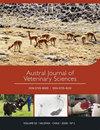Estimation of genetic parameters for milk yield using a random regression test-day model in first parity dairy cows under pasture-based systems of Los Ríos region in Chile
IF 0.8
4区 农林科学
Q3 VETERINARY SCIENCES
引用次数: 0
Abstract
In dairy cattle, genetic selection for milk yield was generally based on 305 days lactation records that were calculated from available monthly test-day milk yield records. A test-day milk yield record, multiplied by the number of days between the current and following test-day, was the monthly milk yield and summed to all other monthly milk yields represented a 305 days lactation yield. Cows that for any reason did not complete their lactation got a 305 days yield via correction factors assuming a common lactation curve. Random regression models allow individual deviation from a common curve. The objective of this study was to estimate genetic parameters for daily milk yield using a random regression model (RRM) in Chilean dairy cows. A data set containing 97,683 monthly test-day records of 10,528 cows from 15 commercial dairy herds of Los Rios Region in southern Chile was used. Days in milk (DIM) were modelled using the fourth-order Legendre polynomials and the model also included, as fixed effects, contemporary group and cow age at test-day as a covariate. The average daily milk yield was 17.83 ± 5.25 kg. Average estimated heritability and repeatability from five to 305 DIM was 0.26 ± 0.02 and 0.61 ± 0.04, respectively. The heritability estimate varied from 0.23 to 0.31. Both parameters did not vary dramatically except after 270 DIM when repeatability increased while heritability decreased. Although the estimated genetic parameters did not seriously depart from the most recent results available in the Chilean literature, they are mathematically more precise for estimating the true parameters than those calculated using adjustment factors, suggesting that the model used could be the starting point to develop a genetic evaluation system for dairy cattle in Chile.利用随机回归试验日模型对智利Los Ríos地区牧场一胎奶牛产奶量的遗传参数进行估计
在奶牛中,产奶量的遗传选择通常基于305天的泌乳记录,这些记录是根据可用的每月试验日产奶量记录计算出来的。测试日产奶量记录乘以当前和下一个测试日之间的天数,即为每月产奶量,并与所有其他月度产奶量相加,即为305天的泌乳量。如果奶牛由于任何原因没有完成泌乳,则通过修正因子假设一个共同的泌乳曲线,得到305天的产奶量。随机回归模型允许个体偏离共同曲线。本研究的目的是利用随机回归模型(RRM)估计智利奶牛日产奶量的遗传参数。使用了智利南部洛斯里奥斯地区15个商业奶牛群的10,528头奶牛的97,683个月测试日记录的数据集。用四阶勒让德多项式(Legendre polynomial)对奶牛的泌乳天数(DIM)进行建模,并将当代人组和试验日奶牛的年龄作为协变量作为固定效应。平均日产奶量为17.83±5.25 kg。5 ~ 305 DIM的平均估计遗传率和重复率分别为0.26±0.02和0.61±0.04。遗传率估计在0.23 ~ 0.31之间变化。除270 DIM后可重复性增加,遗传力下降外,这两个参数变化不大。虽然估计的遗传参数并没有严重偏离智利文献中可用的最新结果,但它们在数学上比使用调整因子计算的参数更精确地估计真实参数,这表明所使用的模型可以作为开发智利奶牛遗传评估系统的起点。
本文章由计算机程序翻译,如有差异,请以英文原文为准。
求助全文
约1分钟内获得全文
求助全文
来源期刊

Austral Journal of Veterinary Sciences
Veterinary-General Veterinary
CiteScore
1.60
自引率
0.00%
发文量
18
期刊介绍:
Austral Journal of Veterinary Sciences (formerly Archivos de Medicina Veterinaria) publishes original scientific contributions in English, containing the latest developments and discoveries in veterinary sciences. The journal covers topics such as animal health and production, preventive medicine, zoonosis, pharmacology and therapeutics, methods of diagnosis, and other areas related to the veterinary field.
Austral Journal of Veterinary Sciences aims to divulge information about advances in veterinary medicine among universities, research centres, industries, government agencies, biologists, agronomists and veterinarians.
 求助内容:
求助内容: 应助结果提醒方式:
应助结果提醒方式:


